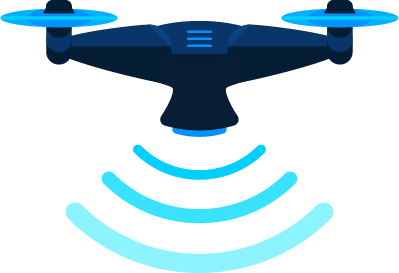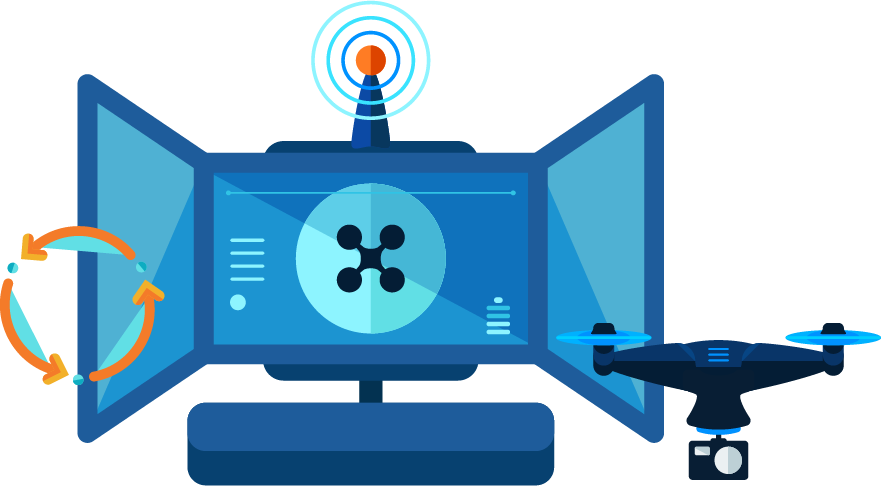- Common Engineering Programme (N71)
- Diploma in Aerospace Engineering (N65)
- Diploma in Biomedical Engineering (N60)
- Diploma in Electrical Engineering (N43)
- Diploma in Electronic & Computer Engineering (N44)
- Diploma in Engineering Science (N93)
- Diploma in Mechanical Engineering (N41)
- Diploma in Mechatronics & Robotics (N50)
- Diploma in Offshore & Sustainable Engineering (N42)
- NP Flight School
- Diploma Plus - CAEM
About NP Flight School
Ngee Ann Polytechnic flight school is an accredited unmanned aircraft training organization (UATO) by Civil Aviation Authority of Singapore (CAAS). We demonstrated the ability to conduct safe, effective and learner centric programs
for our workforce and hobbyists.
All courses are conducted in the safety and comfort at the Ngee Ann polytechnic campus. The campus provides amenities such as shower facilities, multiple canteens, rest area and classrooms for pilot trainees to use within walking distance. Parking is available at public rate. Getting to NP is a breeze with public transport at the door step of the campus.

Singapore is a tropical country with plenty of sunshine and rain. We believe that flight practice under shelter is safer and more productive for our trainees during hot sunny days. On wet and rainy days, trainees can complete their flight practice indoor in the event of rain and extreme wind conditions. Each trainee has their individual simulation set and use them for practice as often as they need during their training period.
Get your unmanned aircraft pilot license (UAPL) safer and faster with NP flight school.
UAPL Courses
Ngee Ann Polytechnic flight school is an accredited unmanned aircraft training organization (UATO) by Civil Aviation Authority of Singapore (CAAS). We demonstrated the ability to conduct safe, effective and learner centric programs for our workforce and hobbyists.
| Training Day | 1 day |
| Credit Hours | 8 |
| Fee | SGD $399 |
| Outdoor Training | NP field |
| Assessment Location | NP field |
Course Synopsis
To qualify for this assessment, the trainees must have passed CAAS theory test and has attained UAPL for multi-rotor Class A. UA pilot must show competence in accordance to CAAS’s passing requirement in operating class size 450
to 550 radio-controlled helicopters. Pilot can bring their own radio-controlled helicopters for the practical assessment.
Candidates will be given time to practise and complete simulator training before the actual practical assessment. This helps candidates warm up and get used to the flight conditions at the test ground before the actual assessment. The practice sessions also improved safety and readiness for the candidates.
NP flight school will send trainee’s practical test results to CAAS electronically. Pilot can apply for the UAPL online by paying the license fee. The UAPL can be retrieved via CAAS’s app SGflight (android/iOS).
Passing the assessment allows the trainees to operate radio-controlled helicopters for commercial purposes and to apply as authorised flight examiners (AFE) at other UA flight schools required by CAAS.
| Training Day | 4 |
| Credit Hours | 45 Hours (includes 13 hours asynchronous learning) |
| Indoor Training | NP classroom |
| Outdoor Training | NP field |
| Assessment Location | NP field |
Course Synopsis
Trainees will attend online lectures on aviation laws, safe UA operations, meteorology and principles of flight. Trainees will role play and work in teams to complete several real-world assignments. They will
learn how to apply for activity permits and prepare flight plans for submission to CAAS. Trainees will learn to conduct site survey to plan risk management. Trainees will also sit for mock tests and complete an online assessment. Upon successfully passing the assessments, trainees will receive a certificate of achievement.
Trainees will practise manoeuvres according to CAAS assessment criteria using simulators and field practice. Trainees will undergo field training using the same manoeuvres that will be completed during the simulator training. Trainees will practise flight patterns using three different UA with different weights and complexities – DJI Spark (light weight and easy to fly), Phantom 4 V2.0 (medium weight, more control required) and MIRS-S1200 (15kg heavy and technically hardest to fly and control).
The 4 day course will help trainees operate a variety of light to heavy UA as part of their job or business. The focus will be on UA lighter than 7kg.
| Training Day | 6 |
| Credit Hours | 66 Hours (includes 18 hours asynchronous learning) |
| Indoor Training | NP classroom |
| Outdoor Training | NP field |
| Assessment Location | NP field |
Trainees will learn to conduct site survey to plan risk management. Trainees will also sit for mock tests and complete an online assessment. Upon successfully passing the assessments, trainees will receive a certificate of achievement.
Trainees will practise manoeuvres according to CAAS assessment criteria using simulators and field practice. Trainees will undergo field training using the same manoeuvres that will be completed during the simulator training. Trainees will practise flight patterns using three different UA with different weights and complexities – DJI Spark (light weight and easy to fly), Phantom 4 V2.0 (medium weight, more control required) and MIRS-S1200 (15kg heavy and technically hardest to fly and control).
The 6 day course will help trainees who are planning to operate heavier UA that is 15kg mainly as part of their job or business.
| Training Day | 4 |
| Credit Hours | 32 Hours |
| Indoor Training | NP classroom |
| Outdoor Training | NP field |
Trainees will complete a practical handling assessment test and receive a certificate of achievement.
| Training Day | 1 Day (with 30 access pass to online notes and materials) |
| Credit Hours | 8 Hours |
Trainees will complete one online mock theory test and one online assessment test to complete the course. Trainees will receive a certificate of achievement on passing the online assessment test.
| Training Day | 1 |
| Credit Hours | 8 Hours |
| Indoor Training | NP classroom |
| Assessment Location | NP field |
Trainees will complete one online mock theory test and one online assessment test within 30 days to complete the course. Trainees will receive a certificate of achievement on passing the online assessment test.
| Training Day | 1 |
| Credit Hours | 8 Hours |
| Outdoor Training | NP field |
| Assessment Location | NP field |
Candidates will be given time to practise and complete simulator training before the actual practical assessment. This helps candidates warm up and get used to the flight conditions at the test ground before the actual assessment. The practice sessions also improved safety and readiness for the candidates.
NP flight school will send trainee’s practical test results to CAAS electronically. Pilot can apply for the UAPL online by paying the license fee. The UAPL can be retrieved via CAAS’s app SGflight (android/iOS).
Passing the assessment allows the trainees to operate multi-rotor UA for commercial purposes.
| Training Day | 1 |
| Credit Hours | 8 Hours |
| Outdoor Training | NP field |
| Assessment Location | NP field |
Candidates will be given time to practise and complete simulator training before the actual practical assessment. This helps candidates warm up and get used to the flight conditions at the test ground before the actual assessment. The practice sessions also improved safety and readiness for the candidates.
NP flight school will send trainee’s practical test results to CAAS electronically. Pilot can apply for the UAPL online by paying the license fee. The UAPL can be retrieved via CAAS’s app SGflight (android/iOS).
Passing the assessment allows the trainees to operate radio-controlled helicopters for commercial purposes and to apply as authorised flight examiners (AFE) at other UA flight schools required by CAAS.

Why Fly With Us
- Every minute of your presence at NP is optimized for helping you to be flight ready from learning how to apply for an actual activity permit to doing basic risk assessment for a project and use the latest implementation of the central flight management
system (CFMS by CAAS)
- Premier training facilities at NP campus
- Visit to the Aviation hub with live size drones, civilian and military aircraft
- Zero waiting time from flight to flight
- Learn at your own pace
- Complete real world UA-related assignments during the course
- Learn from instructors with industry experience and currency
- Hear from guest speakers from the industry to share about real world UA operation (Seasonal)
- Understand the trend of UA development globally
- Attempt multiple online mock tests at home or in campus to prepare for CAAS theory test
- Flipped learning and learn at your own pace for optimal learning for busy individuals
- Attend in-campus tutorial class for CAAS syllabus
- Individual simulator station for unlimited practice during training period
- Fly an UA at your own pace and time within the course duration to build confidence and explore the working of a drone.
- 1:1 trainer to trainee ratio
- Skilfuture credit usable
- SSG funding between 70 - 90% for Singapore citizens and Permanent residents
Funding Available
SSG funding between 70 - 90% for Singapore citizens and Permanent residents
